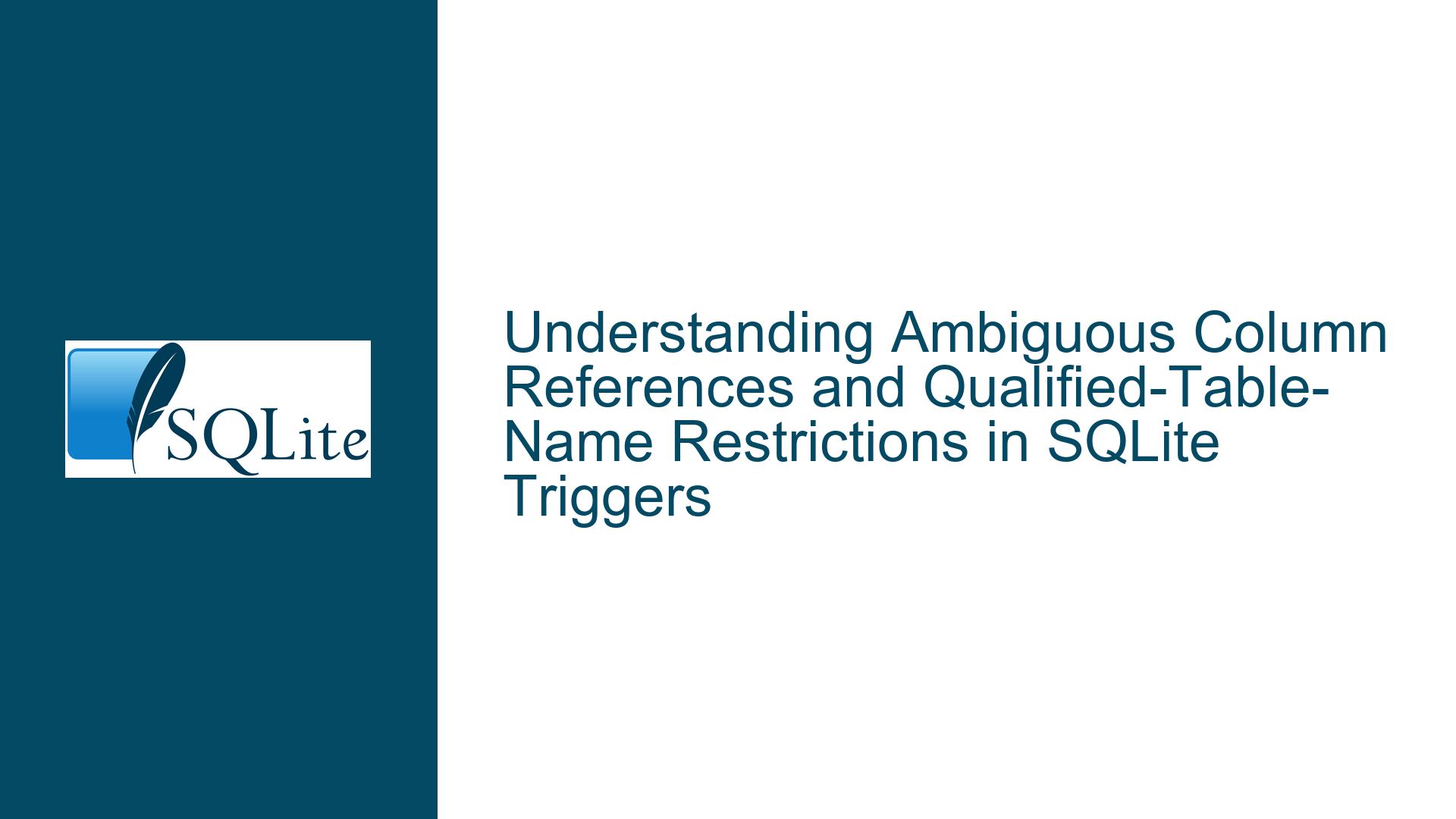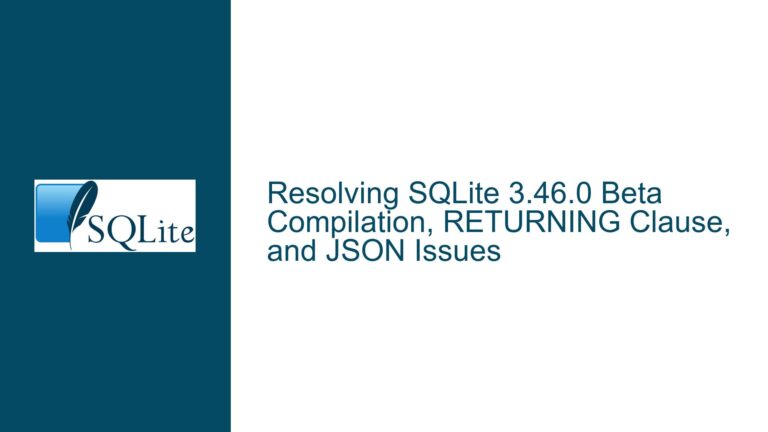Ambiguous Column References and Qualified-Table-Name Restrictions in SQLite Triggers
Issue Overview: Ambiguous Column References and Qualified-Table-Name Restrictions in SQLite Triggers
When working with SQLite triggers, particularly those that perform updates on the same table from which the trigger is fired, developers often encounter two specific challenges: ambiguous column references and the restriction on using qualified-table-names within the trigger body. These issues can lead to unexpected behavior, especially when dealing with complex queries involving subqueries and joins.
In the provided scenario, the developer attempts to update the tb_Object_Head table within a trigger. The goal is to modify the children column by inserting a new value into a JSON array and then updating the array based on certain conditions. The initial approach involves using an alias (c) for the tb_Object_Head table in the UPDATE statement, but this is not allowed due to SQLite’s restriction on qualified-table-names within triggers. The developer then resorts to a subquery to achieve the desired result, but encounters an issue with ambiguous column references, specifically with the children column.
The core of the problem lies in how SQLite resolves column references within subqueries and joins, especially when the same column name exists in multiple tables or aliases. The ambiguity arises because the children column is referenced in both the outer query and the subquery, but SQLite does not throw an error, leading to unexpected results. Additionally, the restriction on using qualified-table-names within triggers complicates the matter, as it prevents the developer from explicitly specifying which table or alias a column belongs to.
Possible Causes: Ambiguity in Column Resolution and Qualified-Table-Name Restrictions
The ambiguity in column resolution within SQLite triggers can be attributed to several factors. First, SQLite’s scoping rules for column references in subqueries and joins are not as strict as those in some other SQL databases. When a column name is referenced in a subquery, SQLite attempts to resolve it by looking at the tables and aliases in the current scope. If the same column name exists in multiple tables or aliases, SQLite may not always throw an error, even though the reference is ambiguous. This can lead to unexpected behavior, as the query might not be operating on the intended table or alias.
In the provided scenario, the children column is referenced in both the outer query and the subquery. The outer query is updating the children column in the tb_Object_Head table, while the subquery is selecting from a derived table that also includes the children column. Since SQLite does not enforce strict scoping rules for column references, the children column in the subquery is implicitly resolved to the children column in the derived table (o), rather than the children column in the outer query. This leads to unexpected results, as the subquery is not operating on the intended column.
The restriction on using qualified-table-names within SQLite triggers further complicates the issue. In SQLite, a qualified-table-name is a table name that is prefixed with a schema name or an alias. For example, schema_name.table_name or alias.table_name. Within triggers, SQLite does not allow the use of qualified-table-names in UPDATE or DELETE statements. This means that developers cannot use aliases to explicitly specify which table or alias a column belongs to, which can lead to ambiguity in column references.
In the provided scenario, the developer attempts to use an alias (c) for the tb_Object_Head table in the UPDATE statement, but this is not allowed due to the qualified-table-name restriction. As a result, the developer must resort to a subquery to achieve the desired result, but this introduces ambiguity in the column references, leading to unexpected behavior.
Troubleshooting Steps, Solutions & Fixes: Resolving Ambiguity and Working Around Qualified-Table-Name Restrictions
To resolve the issue of ambiguous column references and work around the qualified-table-name restriction in SQLite triggers, developers can take several steps. These steps involve carefully structuring the query to avoid ambiguity, using derived tables or common table expressions (CTEs) to explicitly specify column references, and understanding the limitations of SQLite’s scoping rules.
Step 1: Avoid Ambiguity by Explicitly Specifying Column References
One of the most effective ways to avoid ambiguity in column references is to explicitly specify which table or alias a column belongs to. In SQLite, this can be done by using derived tables or common table expressions (CTEs) to create a clear scope for each column reference. In the provided scenario, the developer eventually resolves the issue by using a derived table in the subquery:
UPDATE tb_Object_Head
SET children = (
SELECT json_group_array(a.value)
FROM json_each(json_insert(children, '$[#]', new.id)) AS a
JOIN (SELECT id, product_id, arr_index FROM tb_Object_Head) AS o ON o.id = a.value
WHERE o.product_id IS new.product_id
ORDER BY o.arr_index
)
WHERE id IS new.parent_id AND product_id IS new.product_id;
In this query, the derived table (SELECT id, product_id, arr_index FROM tb_Object_Head) AS o explicitly specifies the columns that are being used in the subquery. This avoids ambiguity by ensuring that the children column in the outer query is not confused with any other columns in the subquery.
Step 2: Use Common Table Expressions (CTEs) for Clarity
Another approach to avoiding ambiguity is to use common table expressions (CTEs). CTEs allow developers to define temporary result sets that can be referenced within the main query. This can make the query more readable and reduce the risk of ambiguous column references. For example, the query could be rewritten using a CTE as follows:
WITH updated_children AS (
SELECT json_group_array(a.value) AS new_children
FROM json_each(json_insert(children, '$[#]', new.id)) AS a
JOIN (SELECT id, product_id, arr_index FROM tb_Object_Head) AS o ON o.id = a.value
WHERE o.product_id IS new.product_id
ORDER BY o.arr_index
)
UPDATE tb_Object_Head
SET children = (SELECT new_children FROM updated_children)
WHERE id IS new.parent_id AND product_id IS new.product_id;
In this query, the CTE updated_children defines a temporary result set that contains the updated children values. The main UPDATE statement then references this CTE to set the children column in the tb_Object_Head table. This approach makes the query more readable and reduces the risk of ambiguity.
Step 3: Understand and Work Around Qualified-Table-Name Restrictions
The restriction on using qualified-table-names within SQLite triggers can be challenging, but there are ways to work around it. One approach is to use derived tables or CTEs, as shown in the previous steps, to explicitly specify column references. Another approach is to use temporary tables or views to create a clear scope for the columns being referenced.
For example, if the tb_Object_Head table is frequently updated within triggers, a temporary table or view could be created to simplify the queries. The temporary table or view could include only the columns needed for the update, reducing the risk of ambiguity. Here is an example of how a temporary table could be used:
CREATE TEMPORARY TABLE temp_Object_Head AS
SELECT id, product_id, arr_index, children
FROM tb_Object_Head;
UPDATE temp_Object_Head
SET children = (
SELECT json_group_array(a.value)
FROM json_each(json_insert(children, '$[#]', new.id)) AS a
JOIN temp_Object_Head AS o ON o.id = a.value
WHERE o.product_id IS new.product_id
ORDER BY o.arr_index
)
WHERE id IS new.parent_id AND product_id IS new.product_id;
-- Update the main table with the results from the temporary table
UPDATE tb_Object_Head
SET children = (SELECT children FROM temp_Object_Head WHERE id = tb_Object_Head.id)
WHERE id IS new.parent_id AND product_id IS new.product_id;
DROP TABLE temp_Object_Head;
In this example, a temporary table temp_Object_Head is created to store the relevant columns from the tb_Object_Head table. The UPDATE statement is then performed on the temporary table, avoiding the qualified-table-name restriction. Finally, the main tb_Object_Head table is updated with the results from the temporary table.
Step 4: Test and Validate Queries to Ensure Expected Behavior
After making changes to the query structure to avoid ambiguity and work around qualified-table-name restrictions, it is important to thoroughly test and validate the queries to ensure that they produce the expected results. This involves running the queries with different data sets and checking the results to ensure that the children column is being updated correctly.
In the provided scenario, the developer initially encountered unexpected results because the children column in the subquery was implicitly resolved to the wrong table. By using derived tables or CTEs, the developer was able to explicitly specify the column references and achieve the desired result. However, it is important to test the final query to ensure that it behaves as expected in all cases.
Step 5: Consider Alternative Approaches for Complex Updates
In some cases, the complexity of the update operation may warrant considering alternative approaches. For example, if the update involves multiple steps or complex logic, it may be more efficient to perform the update outside of the trigger, using a stored procedure or application code. This can simplify the trigger logic and reduce the risk of ambiguity and unexpected behavior.
For example, instead of performing the update within the trigger, the trigger could be used to set a flag or store the necessary data in a temporary table. The actual update could then be performed by a separate process, such as a stored procedure or application code. This approach can make the trigger logic simpler and more maintainable, while also reducing the risk of ambiguity and unexpected behavior.
Conclusion
Ambiguous column references and qualified-table-name restrictions are common challenges when working with SQLite triggers, particularly when performing updates on the same table from which the trigger is fired. By carefully structuring queries to avoid ambiguity, using derived tables or CTEs to explicitly specify column references, and understanding the limitations of SQLite’s scoping rules, developers can work around these challenges and achieve the desired results. Thorough testing and validation are essential to ensure that the queries behave as expected, and in some cases, alternative approaches may be necessary to simplify complex update operations.






